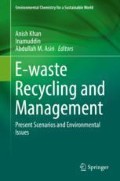Abstract
The increasing level of Electronic-waste and its improper disposal and unsafe treatment pose significant risks to the environment and human health. They raise several challenges to the sustainable development goals. Electronic-waste is considered one of the fastest-growing pollution problems all over the world as per the United Nations environment programme estimates. This rapid growth is influenced by planned product extinction, lower prices, and change of lifestyle. Unfortunately, a major amount of Electronic-waste is recycled in the informal sector and results in toxic exposures to the recyclers, especially to women and children. Electronic-waste consists of valuable metals as well as environmental contaminants especially polybrominated diphenyl ether and polychlorinated biphenyls. The chemical composition of Electronic-waste changes with the innovation of new technologies and pressure from environmental organizations. As the reprocessing and recycling technologies with minimal environmental impacts are found to be expensive, rich countries export unknown quantities of Electronic-waste to developing countries, where recycling techniques including burning and dissolution in strong acids result in localized contaminations of water and food chains. This chapter deals with the generation of electronic-waste and its disposal pathways, and it especially covers the various contaminants that affect human health as well as our environment.
Access this chapter
Tax calculation will be finalised at checkout
Purchases are for personal use only
References
Baldé CP, Wang F, Kuehr R, Huisman J (2015) The global electronic waste monitor — 2014
Baldé CP, Forti V, Gray V, Kuehr R, Stegmann O (2017) The global Electronic waste monitor-2017, Quantities, flows and resources, United Nations University (UNU), International Telecommunication Union (ITU) & International Solid Waste Association (ISWA), Bonn/Geneva/Vienna
BullionStreet (2012) Electronics industry uses 320 tons of gold, 7500 tons of silver annually., Retrieved May 6, 2016, from http://www.bullionstreet.com/news/electronics-industry-uses-320-tons-of-gold7500-tons-of-silver-annually/2255
Bustamante ML, Gaustad G (2014) The evolving copper–tellurium byproduct system: review of changing production techniques & their implications, pp 11–16
Ceballos DM, Dong Z (2016) The formal electronic recycling industry: challenges and opportunities in occupational and environmental health research. Environ. Internat. 95:157–166
Choi JK, Fthenakis V (2014) Crystalline silicon photovoltaic recycling planning: macro and micro perspectives. J Clean Product 66:443–449
Compendium of technologies for the recovery of materials from WEEE/Electronic waste, UN environment, 17 Oct 2016, http://web.unep.org/ietc/sites/unep.org.ietc/files/Electronicwaste%20Compendium%2017%20Oct%202016.pdf
Cucchiella F, D’Adamo I, Lenny Koh SC, Rosa P (2015) Recycling of WEEEs: an economic assessment of present and future electronic waste streams. Renew Sust Energ Rev 51:263–272
Golev A, Schmeda-Lopez DR, Smart SK, Corder GD, McFarland EW (2016) Where next on electronic waste in Australia? Waste Manag 58:348–358
Grant K, Goldizen FC, Sly PD et al (2013) Health consequences of exposure to electronic waste: a systematic review. Lancet Glob Health 1:350–361
Guo H, Gong Y, Gao S (2010a) Preparation of high strength foam glass–ceramics from waste cathode ray tube. Mater Lett 64:997–999
Guo QJ, Yue XH, Wang MH et al (2010b) Pyrolysis of scrap printed circuit board plastic particles in a fluidized bed. Powder Technol 198:422–428
Hall WJ, Williams PT (2007) Analysis of products from the pyrolysis of plastics recovered from the commercial scale recycling of waste electrical and electronic equipment. J Anal Appl Pyrolysis 79:375–386
Heeks R, Subramanian L, Jones C (2015) Understanding electronic waste Management in Developing 727 countries: strategies, determinants, and policy implications in the Indian ICT sector. Information Technol Develop 21:653–667
Herat S (2008) Recycling of cathode ray tubes (CRTs) in electronic waste. Clean (Weinh) 36:19–24
IBT (International Business Times), 2012. Electronic waste rich in silver and gold, but most unrecovered, Experts Say. 6 Jul, 12, from: http://www.ibtimes.com/electronic waste-rich-silver-and-gold-most-unrecovered-experts-say-721602
International Telecommunication Union (2017) Status of the transition to Digital Terrestrial Television Broadcasting, from: http://www.itu.int/en/ITUD/SpectrumBroadcasting/Pages/DSO/Default.aspx
International Telecommunication Union–Radiocommunication Sector (2015) ITU-R FAQ on the Digital Dividend and the Digital Switchover, from: http://www.itu.int/en/ITU-R/Documents/ITUR-FAQ-DD-DSO.pdf
Kumar A, Holuszkoa M, Espinosa DCR (2017) Electronic waste: an overview on generation, collection, legislation and recycling practices. Resour Conserv Recycling 122:32–42
Li J, Zeng X, Chen M et al (2015) Control-alt-delete rebooting solutions for the electronic waste problem. Environ Sci Technol 49:7095–7108
Lohse J, Winteler S, Wulf-Schnabel J (1998) Collection targets for waste from electrical and electronic equipment (WEEE) the directorate general (DG XI) environment. Nuclear safety and civil protection of the Commission of the European Communities
Needhidasan S, Samuel M, Chidambaram R (2014) Electronic waste – an emerging threat to the environment of urban India. J Environ Health Sci Eng 12:36
Osibanjo O, Nnorom IC (2007) The challenge of electronic waste (electronic waste) management in developing countries. Waste Manage Res 25:489–501
Siddiqi MA, Ronald H. Laessig RH et al (2003) Polybrominated diphenyl ethers (PBDEs): new pollutants-old diseases. Clin Med Res 1(4): 281–290
Step Initiative (2014) One Global Definition of Electronic waste. United Nations University, Bonn, Germany, Retrieved from http://www.step-initiative.org/files/step/documents/StEP WP OneGlobalDefinitionofElectronic waste 20140603 amended.pdf
Tsydenova O, Bengtsson M (2011) Chemical hazards associated with treatment of waste electrical and electronic equipment. Waste Manag 31(1):45–58
UNEP Blog (2014) Electronic waste, the fastest growing waste stream in the world available at. http://www.unep.org/unea/e_waste.asp
United Nations University, The Global Electronic waste Monitor 2014: Quantities, Flows and Resources, From: http://i.unu.edu/media/unu.edu/news/52624/UNU-1stGlobal-Electronic waste-Monitor-2014-small.pdf [accessed Jan 08 2016]
Veit HM, Bernardes AM (2015) Electronic waste. Springer
Yi R, Chen X, Shen L, Hu J (2007) Study on the equipment for automatic dismantling of electronic components in printed circuit boards scrap. Agricultural Equipment & Vehicle Eng 9:46–48. (in Chinese)
Zhou L, Xu Z (2012) Response to waste electrical and electronic equipments in China: legislation, recycling system, and advanced integrated process. Environ Sci Technol 46:4713–4724
Author information
Authors and Affiliations
Corresponding author
Editor information
Editors and Affiliations
Rights and permissions
Copyright information
© 2020 Springer Nature Switzerland AG
About this chapter
Cite this chapter
Grace Pavithra, K., Sundar Rajan, P.S., Balaji, D., Gopinath, K.P. (2020). Sustainable Electronic-Waste Management: Implications on Environmental and Human Health. In: Khan, A., Inamuddin, Asiri, A. (eds) E-waste Recycling and Management. Environmental Chemistry for a Sustainable World, vol 33. Springer, Cham. https://doi.org/10.1007/978-3-030-14184-4_11
Download citation
DOI: https://doi.org/10.1007/978-3-030-14184-4_11
Published:
Publisher Name: Springer, Cham
Print ISBN: 978-3-030-14183-7
Online ISBN: 978-3-030-14184-4
eBook Packages: Earth and Environmental ScienceEarth and Environmental Science (R0)

